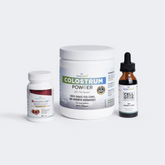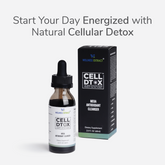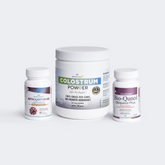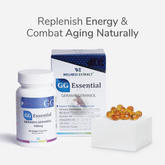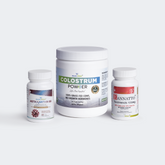Estimated Reading Time: 6 minutes
|Guide to Hormonal Balance: Normal Testosterone and Estrogen Levels in Women
Hormones are vital to a woman’s health, affecting everything from mood and stamina to metabolism and reproductive health. Estrogen and testosterone are two of the most essential hormones in the body of a woman. Although estrogen is often referred to as the “female hormone” and testosterone as the “male hormone,” both exist in women and must be in balance for optimal health.
In normal amounts, these hormones promote a healthy body and mind. However, imbalances can do great damage to the body, giving rise to symptoms such as fatigue, mood swings, skin issues, weight gain, reproductive problems, and conditions like osteoporosis or polycystic ovary syndrome (PCOS).
Knowing what balanced or normal testosterone and estrogen levels in women should look like is key to identifying hormonal imbalances early and taking steps to support overall well-being. Hence, sustaining them is essential for long-term health and wellness.
In this article, let’s discuss what exactly testosterone and estrogen are, their functions, the factors influencing them, and their normal levels in each stage of a woman's life.
What Are Testosterone and Estrogen?
-
Testosterone in Women
Testosterone is the primary sex hormone in males. It plays a vital role in male development and masculine traits. Though mostly associated with men, testosterone is important for women too. It helps with:
-
Muscle Strength and Bone Density
-
Energy levels and metabolism
-
Mood and brain function
-
Sex drive (libido)
-
Red blood cell production
-
Fat distribution in the body
Women have testosterone-producing cells in the ovaries and adrenal glands, though they secrete it at much lower levels than men. Although testosterone is comparatively a small part of the female hormone profile, it is key to keeping us feeling youthful and strong.
Also read Breaking barriers: The Impact of Geranylgeraniol on Testosterone Levels.
-
Estrogen in Women
Estrogen, one of the primary female sex hormones alongside progesterone, plays a vital role in reproductive health. It supports the development of secondary sex characteristics, regulates menstruation, and influences pregnancy and menopause. As the main female hormone, estrogen is responsible for:
-
Control and regulation of the menstrual cycle
-
Keeping bones and heart healthy
-
Promoting skin elasticity and hair development
-
Regulating the distribution of fat in the body
-
Aiding cognitive function
Estrogen is mostly made in the ovaries, but small amounts also come from the adrenal glands and fat tissue. The body has three main types of estrogen — estradiol (E2), estrone (E1), and estriol (E3) — with estradiol being the main type during a woman’s childbearing years.


Testosterone and Estrogen Levels in Women by Age
Knowing normal hormone levels can make it easier to spot any imbalances that might be causing issues such as fatigue, weight gain, or mood swings.
-
Female Normal Estrogen Levels (Estradiol — E2)
-
Pre-puberty: <20 pg/mL
-
Reproductive years: 30–400 pg/mL (depends on the phase of menstruation)
-
Perimenopause: Levels vary and slowly decrease
-
Postmenopause: Below 30 pg/mL
Estrogen levels change throughout a woman’s menstrual cycle, rising to a peak just before ovulation and decreasing to a low just before menstruation. Vastly decreasing estrogen production after menopause can cause hot flashes, mood changes, and increased risk of bone loss, among other common symptoms.
-
Testosterone Levels in Females: Normal Range
-
Average range: 15–70 ng/dL (may slightly differ by age)
-
Saturation in the 20s: Age naturally reduces levels
-
Postmenopause: Levels may decrease even more, leading to low libido and energy
As mentioned earlier, women have lower testosterone levels than men, but even small imbalances can affect mood, energy, and overall well-being. Low testosterone in women is sometimes linked to fatigue, low motivation, and reduced muscle strength.
Moving forward, let’s discuss the factors that influence the hormone levels in women, what causes them, and how to keep hormones in balance.
5 Factors That Influence Hormone Levels
Estrogen and testosterone levels are affected by many factors, including:
-
Natural Life Stages: Hormone production is impacted naturally by puberty, pregnancy, and menopause.
-
Hormonal Disruption: Poor diet, lack of sleep, high stress, and little exercise can also disrupt hormone balance.
-
Medical Conditions: Polycystic ovary syndrome, thyroid disorders, and menopause are some medical conditions that cause drastic changes in hormonal levels.
-
Medications: Birth control pills, hormone replacement pills, and some medications can affect hormonal balance.
-
Environmental Factors: Endocrine disruptors, such as chemicals in BPA-containing plastics, can interfere with normal hormone function.
Now that you know the factors influencing hormone levels, let’s explore the signs so you can take steps to keep them balanced.
Signs of Hormonal Imbalance in Women
When estrogen or testosterone levels are too high or too low, symptoms may become apparent.
-
Signs of High Estrogen:
-
Unexplained weight gain
-
Mood swings and irritability
-
Heavy or irregular periods
-
Breast tenderness
-
Bloating
-
Fatigue
-
More anxiety or depression
-
Signs of Low Estrogen:
-
Hot flashes and night sweats
-
Dryness and discomfort in the vagina
-
Trouble concentrating (“brain fog”)
-
Weak bones (risk of osteoporosis)
-
Decreased skin elasticity
-
Irregular or missed periods
-
Signs of High Testosterone:
-
Excess body or facial hair (hirsutism)
-
Acne or oily skin
-
Irregular menstrual cycles
-
Hair thinning or male-pattern baldness
-
Voice deepening ( in severe cases)
-
Signs of Low Testosterone:
-
Fatigue and low energy
-
Decreased libido
-
Loss of muscle mass
-
Increased body fat
-
Difficulty maintaining focus
-
Depression or irritability
How to Keep Your Hormones in Balance
Fortunately, the right lifestyle choices can help to optimize hormone balance.
-
Diet Tips:
-
Eat healthy fats (avocados, nuts, olive oil) to help support hormone production.
-
Include foods high in fiber (vegetables, whole grains) in your diet to help regulate estrogen levels.
-
Eat protein (eggs, fish, tofu) in the morning activates muscle and metabolic support.
-
Cut out processed foods and excessive sugar to prevent hormone spikes.”
-
Stay well-hydrated and cut back on alcohol and caffeine.
-
Lifestyle Changes:
-
Include strength training and cardio.
-
Get your sleep (7-9 hrs a night) to help regulate hormones.
-
Relieve stress with meditation, yoga, or deep breathing.
-
Minimize toxins and endocrine disruptors lurking in some plastics, cosmetics, and cleaning products.
-
Add natural ingredients like Vitamin E -Tocotrienols after getting professional advice.
-
Medical Treatments:
-
Hormone replacement therapy (HRT) for menopause symptoms.
-
Supplements (like vitamin D or magnesium, or herbal remedies, though consult a doctor first).
-
Medications for diseases such as PCOS or thyroid issues.
Even after trying everything, if the symptoms persist, know when to see the doctor.
When to See a Doctor
But if you’re experiencing symptoms that point to hormonal imbalance, you should get tested. Blood tests can check levels of estrogen, testosterone, and other hormones, which may help diagnose any problems. A doctor could then prescribe personalized treatments to restore normal testosterone and estrogen levels in women.
Women with severe PMS (premenstrual syndrome), persistent fatigue, irregular cycles, or unexplained weight changes should see a healthcare provider. In certain scenarios, you could have underlying conditions, such as insulin resistance, adrenal dysfunction, or thyroid disease.
Conclusion
Understanding how testosterone and estrogen levels work in women helps maintain hormonal balance and overall health. No matter if you are in your 20s, 40s, or postmenopause, monitoring these hormones can be a way to prevent health problems and increase quality of life. If you suspect one is out of balance, changes to your lifestyle and doctor’s guidance can help put you back on the right track.
By making informed decisions about your diet, exercise, hormone-supporting supplements, and self-care, you can support your body’s natural hormone balance and feel your best at any age. Just keep in mind that hormones affect more than reproductive health—they affect everything from mood to metabolism to muscle strength. By taking care of your hormonal health, you take care of your overall quality of life.
Disclaimer: The material provided in this article is for purely educational and informational purposes and should not be used as a substitute for professional medical advice, diagnosis, or treatment. Always consult with your physician or other qualified healthcare provider with any questions regarding a medical condition.
References
-
Harvard Health (2023) Testosterone: What it is and how it affects your health. https://www.health.harvard.edu/staying-healthy/testosterone--what-it-does-and-doesnt-do#:~:text=Testosterone%3A%20What%20it%20is%20and%20how%20it%20affects%20your%20health.
-
Hospital, A.V. (2024a) 'More than Estrogen: The benefits of caring for Women’s hormones,' Aspen Valley Hospital, 3 May. https://www.aspenhospital.org/healthy-journey/more-than-estrogen-the-benefits-of-caring-for-womens-hormones/#:~:text=Hormonal%20Imbalance%3A%20Causes%20and%20Symptoms.
-
Severson, A. (2024) Testosterone levels by age. https://www.healthline.com/health/low-testosterone/testosterone-levels-by-age#:~:text=SUBSCRIBE-,Testosterone%20Levels%20by%20Age,-Testosterone%20levels%20chart.





















